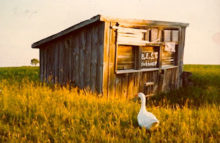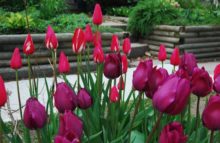| Beautiful yellow trout lily (Erythronium – perhaps ‘Pagoda’?) from Barry Parker’s Parkdale garden |
Spring has arrived, and now we’re waiting impatiently for it to actually begin. But just because there are blank, snowy spots where your plants are supposed to be doesn’t mean you can’t be thinking about what to plant between them next year. In fact, each season in season is the best time to take notes.
So, rather than my intended Canada Blooms 2014 Wishlist, which can wait till next Friday (get your thinking caps on, we can brainstorm together), this Friday Idea File covers four springy plant families you’ll wish you’d planted this year – so that you can consider them for next.
1. Trout lilies (Erythronium)
 |
| Light illuminating the white petals of an Erythronium in Queen Victoria Park, Niagara Falls in April 2012 |
This native North American geophyte or bulb is pure fairy magic, with recurved petals and trout-spotted leaves, hence the common name. It is
in fact a member of the large lily family, along with a couple of other cousins in this post. Best in moist, humusy soil over winter and spring, it will take a drier summer dormancy. Last fall, I planted E. ‘Pagoda’ at the dappled edge of my dry shade garden.
2. Species o
r botanical tulips (Tulipa)
 |
| Tulipa humilis ‘Little Princess’ will also have a place in my garden this year |
These wee pretties are the diverse parents of the larger bulbs we associate with the word “tulip.” To the many original species, we now add numerous named cultivars that retain the miniature form of their folks. Species tulips are more perennial in nature than their hybridized offspring, which tend to run down after a few seasons. Lower growing and long blooming, they like to be tightly spaced and form a bright mat of colour near the front of your garden bed. Their open form begs to be gazed into.
 |
| Tulipa clusiana, possibly ‘Cynthia’, is a little taller at about 25 cm (just under a foot tall) |
 |
| They aren’t all in the yellow range. This is T. clusiana ‘Lady Jane’ in my garden, and other species are in pinks or mauves |
3. Fritillaries (Fritillaria)
 |
| Fritillaria hermonis ‘Amana’, a rarer, exotic form, again from the lovely garden of Barry Parker |
Fritillarias have nodding, bell-like flowers that range widely from tiny to towering, and from white through yellow to deepest plum, many with unique patterning. Some are native to North America, although these don’t include the three shown here. Like all bulbs, they like a well-drained position, and prefer moisture during the growing and flowering period. And while they do go int
o sum
mer dormancy, the soil during that time should probably not be bone dry. Mine dwindled away for that reason. Still, I’d plant them again, even if they turned out to be short lived. They’re adorable.
 |
| Barry’s naturalized
online pharmacy buy biltricide with best prices today in the USA
patch of Fritillaria meleagris, the checkered or snakeshead lily, including the all-white form |
 |
| Tall crown imperials (Fritillaria imperialis) in St. James Park at the end of April 2010 |
4. Bloodroot (Sanguinaria)
 |
| My own double bloodroot (Sanguinaria canadensis ‘Multiplex’) was a gift from Kathy Purdy of Cold Climate Gardening |
Native to moist, open woodlands in North America, bloodroot is the only herbaceous perennial in this post; all the rest are bulbs. But it’s one of the earliest spring bloomers and, especially in the double form, can be delicately showy, like its cousins in the poppy family. I love the way the new leaves enfold the flower bud like an offering. The leaves themselves are also large and dramatically frilled, although they will disappear when the plant retreats into dormancy once the trees above leaf out.
 |
| Sanguinaria canadensis ‘Roseum’ is the pink species of the single form, more obviously pink in real life |
For information on bulbs for all seasons, do check out the excellent Pacific Bulb Society website, which is loaded with pictures and information. Or join the Greater Toronto Bulb Society, to meet g
ardeners who are often willing to share more than just information. Gardeners are like that.
So share your own thoughts: What plant families would you add to this list?





10 comments
So right you are! I have been steadily increasing my Erythronium collection, and adore E. revolutum and japonica which both offer delightful pink flowers! I did manage to end up with a smashing whipped buttery yellow one in place of what was to be a white one, but who can complain with their delightful reflexed petals and spotted foliage. I added bot tulips as well! I would add the DeCaen Anemones, especially 'Blue Poppy' if you have a protected siting for them as they are not reliably hardy in our neck of the woods. 'BP' is large in all its parts and always stops visitors in their tracks!
Barry, I've resisted DeCaen anemones simply due to their lack of hardiness — especially in the heart of the city where our snow cover in the chill of January/February isn't *usually* reliable (Winter 2013, notwithstanding). But they are gorgeous flowers and of course you, being the King of the Blues, would have them.
Oh my, these are all just so beautiful! I had never seen Fritillaria meleagris before…how stunning!
They're quite fascinating with their checkered petals.
My favourite spring walk takes me through the woods at my garden in Quebec's Eastern Townships where trout lilies spot the woods. It's a wonderful sight.
Pat, you are so lucky! I remember seeing trout lilies and especially trillium in abundance in the woods around Markham and Stouffville, Ontario, where we spent part of our childhood. At the time, I just took them for granted. It's not a typical sight anymore, sadly.
Erythronium americanum ( Trout Lily) is native in eastern Canada and the US, but I rarely see it in gardens. Well not entirely true, I have it in my garden but it never blooms. I've been told that it has to find the right depth, and that it will eventually find the right depth, but I've waited for years and still no flowers.
Pat is so lucky to have natural woodland with an existing colony of E. americanum.
Thanks, Barry, for inspiring me to plant Erythronium. I did last fall, and am eager to see how it fares in my garden.
Botanical tulips deserves more attention as they are often longer-lived and more carefree than the high breed standard tulips.
I agree completely, Nelson. Squirrels have made me all but give up on hybrid tulips in my garden, but (so far) they're less destructive of the botanicals. Unfortunately, a big patch of Tulipa tarda (now reclassified as Dasystemon tarda) was disturbed when we did our garden reno (and I didn't get to the ever-intrepid Mr. TG soon enough to save them). But it had been happily filling a dry corner of my garden with sunshine for years. I have added 3-4 more species over the last couple of years.